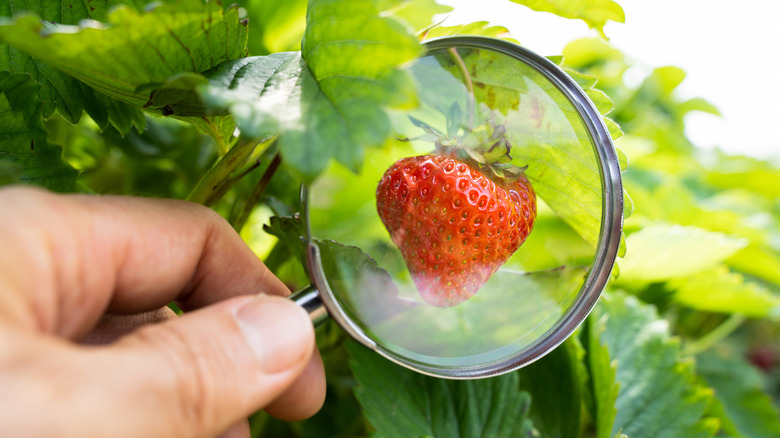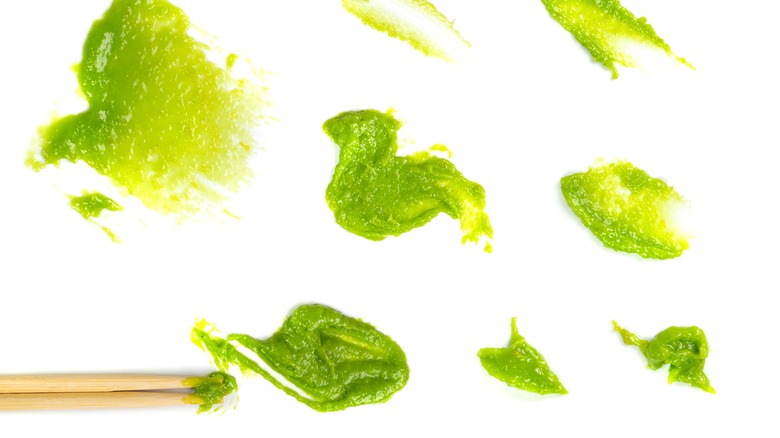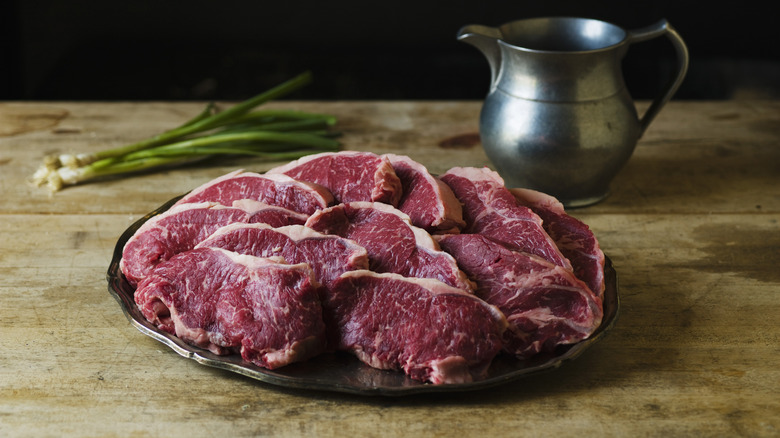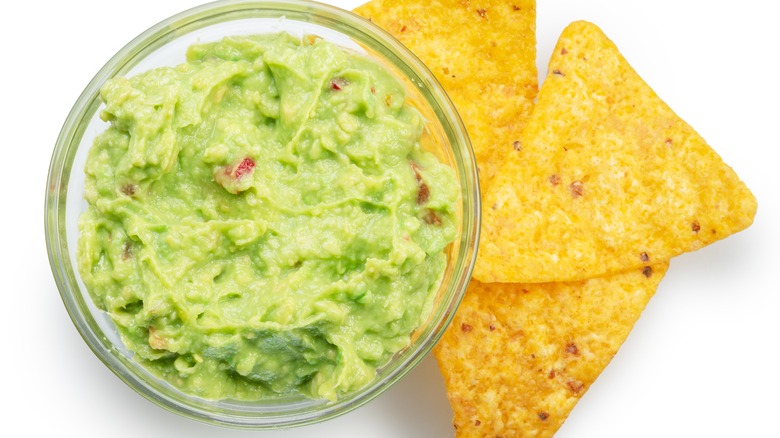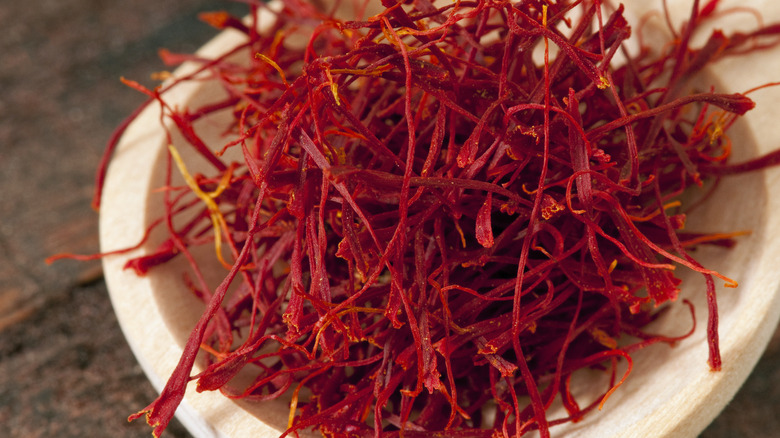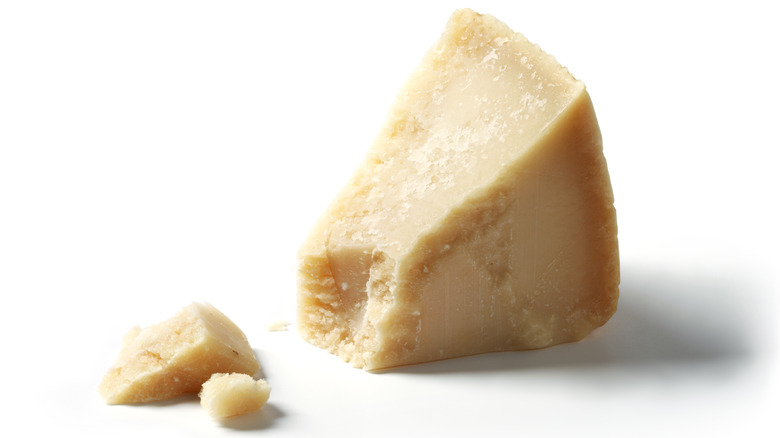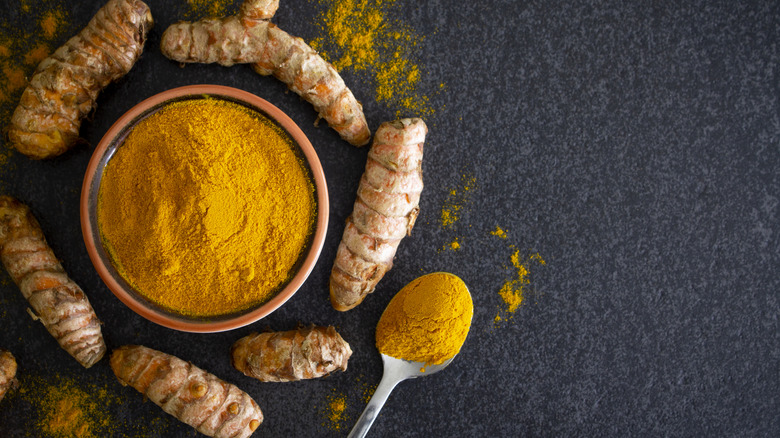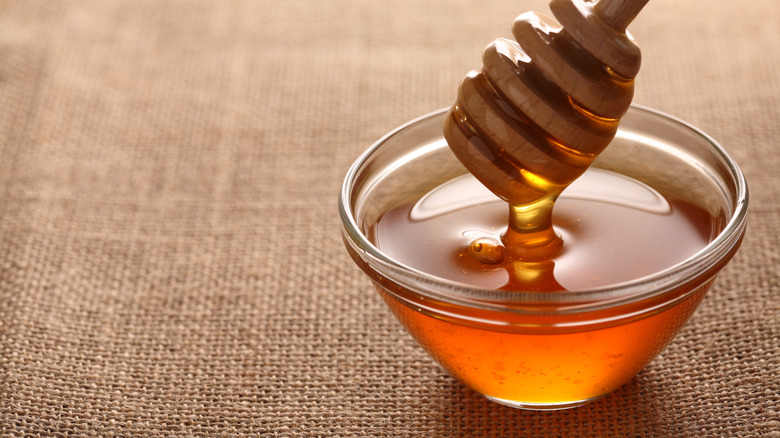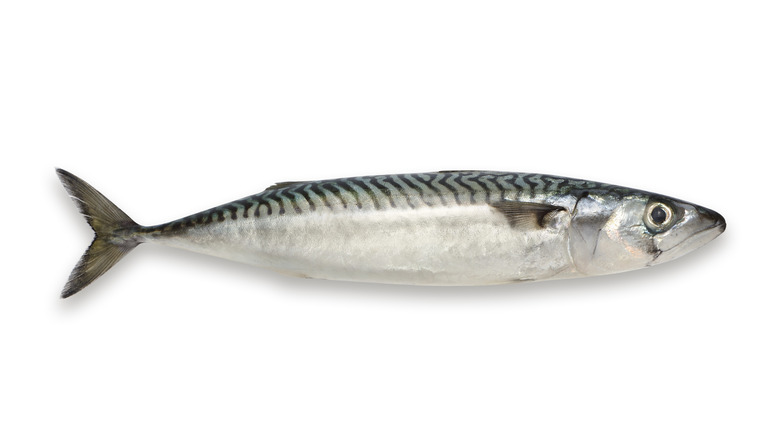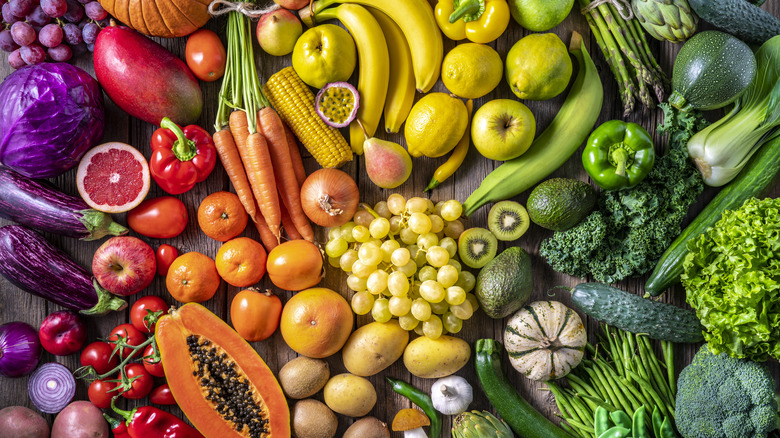Everyday Foods That Aren't Really What They Seem
The old adage that you get what you pay for has always been tempered by the truism that there are times when you actually don't. We live in a world of deep-fake videos, phishing scams, Instagram filters, and disseminated misinformation. The internet sells us a bewildering array of shortcuts, hacks designed to make our lives a little easier, tips and tricks that pique our curiosity and disappoint in equal measure. But at least we can trust our senses, right?
Sadly, not even the food on our plates is spared the indignity of the modern world's occasional slights of hand. Those gigantic machines of industry that work tirelessly to put food in our bellies often feel distant and invisible, but for all their discretion, they exist in a world of tight margins, stiff competition, and insatiable ambition. Such ambition leads to cutting corners, small acts of misdirection, half-truths, and sophistries that often fall short of actual fraud. Below are some of the more egregious samples of everyday foods that aren't what they seem and a few examples of those times when you don't get what you pay for.
Wasabi
Sushi has been around for a lot longer than most people think. Consumed in Japan since the late Yayoi period, it arrived in the West in the post-war years and began its slow march to widespread acceptance during the 1960s. Arguments over which type of sushi is best aren't going away anytime soon, but most people agree that sushi would not be where it is today if it were not for two standby ingredients: soy sauce and wasabi.
The Japanese began cultivating wasabi during the Edo period, a period of isolationism that started in the early seventeenth century. A notoriously slow-growing plant, wasabi requires shade, humidity, and a temperate clime in equal measures. While it thrives in its natural habitat — the mountain streams of Japan — attempts to grow it elsewhere often fail.
The difficulty of cultivating this brittle, stubborn little plant presented a problem for those wishing to exploit the rise in demand. Small wonder, then, that there is a distinct possibility that you've never even tasted real wasabi. In fact, most wasabi consumed outside of Japan is, in reality, a blend of mustard, horseradish and food coloring.
Beef
Beef is one product that seems so distinctive and easily identifiable that nobody could ever pass off a substitute and get away with it. Yes, we've all mixed up our cottage from shepherd's pie. Sure, nobody blames us for not knowing a barbecue brisket from a chuck stew, but the essential characteristics of beef are so firmly lodged in our collective consciousness as to be beyond reproach. Which is probably why it surprised so many people when they discovered that their beef lasagna turned out to be a little more equine than bovine.
The scandal erupted in 2013 when the British Food Standards Agency (FSA) discovered that much of the meat in several Findus Frozen Beef Lasagne was, in fact, horse. The FSA tested 18 meals, 11 of which contained between 60% and 100% horse meat. While the FSA did not consider these impurities a public health issue, it still ordered additional tests for the presence of potentially harmful veterinary drugs.
Plot twists, however, abounded when Findus — a pan-European frozen food conglomerate — indicated that they, too, were the victims of fraud. In a statement issued to the French Agency for Food, they pled ignorance of the matter, blaming the supplier and asking the somewhat pertinent question: "How is it possible that in 2013, horsemeat could be sold with a French label advertising it as beef?"
Guacamole
Students of cuisine will know that a mole sauce or mōlli is a type of sauce or marinade used in Mexico and that guacamole stems from the word āhuaca or avocado. This literal "avocado sauce" dates back to the Aztec empire of the 15th century, when locals mixed avocado, tomatoes, and green chillies and ate them with tortillas.
Modern guacamole recipes often call for adding lime juice, cilantro, or even a little fresh mango, but pretty much everyone you might care to ask agrees on one thing. While there are 1001 mōlli you can make without avocado, guacamole isn't one of them.
In 2006, a Los Angeles woman sued Kraft Foods because its guacamole contained less than 2% avocado. Kraft responded by relabelling its product and reinforcing that its dip is avocado-flavored, not avocado per se. Still, the damage had been done, and the idea that guacamole was simply one of those things best whipped up at home gained traction.
Today, thanks to improved technologies that help keep avocados fresh and firm, much of the guacamole sold in stores is 100% avocado. As with most things, it's generally best to check the label before you buy something as notoriously tricky to package as an avocado sauce.
Saffron
Having examined the potential for food fraud in-depth, you might be forgiven for being skeptical about anything and everything that finds its way onto your plate. But, for the record, saffron really is more expensive than gold.
Cost aside, saffron is a versatile, fragrant, and delicious spice that has remained part of the human diet for around 3500 years. Often used as a condiment for rice in countries such as Iran, Spain, and India, Saffron has a myriad of medicinal uses that complement its reputation as one of the most prized ingredients in the world.
In fact, a staggering 70,000 flowers are needed to produce a single pound of saffron, and — as with wasabi — the delicate nature of the product means that all harvesting is done by hand. It's little wonder, then, that industry moguls sometimes play fast and loose with their definition of saffron.
Adulteration of saffron is more common in powdered saffron, where turmeric — more on that later — paprika and even artificial dyes are sometimes added to the product. Whole saffron, however, isn't immune from the tipped scales of commercial mummery either. Parts from the stigmas of other plants often find themselves combined with oils that increase weight and dyes that add vibrancy. Other contaminants include the less aromatic parts of the saffron flower that should have been removed at harvest.
Parmesan cheese
In 1666, as the Great Fire of London swept past Samuel Pepys's house — en route to destroying some 436 acres of the teeming metropolis — the aspiring diarist took the time to bury his wheel of parmesan cheese in the back garden. It was, after all, his most prized possession.
Even today, a well-aged Parmigiano Reggiano can cost over $700 for an 85-pound wheel of Italy's finest. Indeed, the cheese is so valuable that Italian farmers have often used it as collateral for loans. Meanwhile, some 430,000 wheels of cheese with a reported value of $190 million euros are kept safe in a high-security bank at any given time. Little wonder then that some producers are willing to place their thumb on the scale.
Those packets and tubs of sprinkled cheese commonly found in the US are about as far removed from the real deal as a Hershey's kiss is from a peck on the cheek. Authentic Parmigiano-Reggiano — as opposed to parmesan cheese in general — must, by definition, come from one of these Italian regions: Parma, Modena, Mantua, Bologna, or Reggio Emilia. Any product sold without specific reference to these regions might still taste great in eggplant parmesan, but authentic, it most definitely is not.
Turmeric
Turmeric is a member of the ginger family, and, like its spicier cousin, it is a rhizome. A rhizome is defined as a stem that grows just below the soil's surface and is often mistakenly referred to as a root. Famed for its medicinal properties, warm aromatic flavor profile, and bright yellow hue, humans have been using the spice for over 4000 years.
As with many other items on this list, turmeric is expensive. Its cost seems to have risen in response to an increase in the popularity of Indian cuisine coupled with an extended moment in the spotlight as a health supplement par excellence. According to Food Control, Volume 139, as much as 20% of all turmeric sold contains atypical ingredients such as flour, starches, and potentially toxic elements used to replace the vibrancy of color lost when fraudsters add other compounds. Thankfully, consumers can check the integrity of their turmeric via a simple yet effective water test.
Honey
Versatile and healthy, honey is high in energy, contains a wealth of vitamins, and can be added to everything from a cup of tea to a deliciously indulgent honey cake. It is also so inhospitable to bacteria that it is sometimes used in wound dressings. Indeed, honey's antibacterial properties are so formidable that when archaeologists at a dig site in Egypt stumbled across a 3000-year-old jar of the sweet condiment, they discovered it was still edible. Almost all of the honey consumed worldwide comes from managed bee hives. A single hive can produce as much as 60 pounds of surplus honey in a year.
Still, the relative complexity of honey gathering, coupled with the reality that some bee hives are more productive than others, contributes to its high cost and seasonally adjusted availability. It is hardly surprising that much of the honey we consume is fake. The exact percentage is contested, ranging from 27% to 33% of all honey available being adulterated in some capacity. For small-scale honey producers such as Funny Bug Bees, the solution to the problem is simple enough. A quick phone call to your local agricultural extension office can connect you with local suppliers of pure honey.
Fish
There are around 33,000 known species of fish worldwide, although humans — picky eaters that we are — consume a relatively small sample of them regularly. Surprisingly, according to the National Fisheries Institute, salmon and not tuna — the star of many a quick salad or sandwich — is the most consumed fish in the United States, with tilapia and Alaska pollock occupying the third and fourth spots. That said, our lack of adventurism when selecting fish might be even more pronounced than we think, considering the number of times we've probably eaten a mislabeled product.
A 2021 article published in The Guardian where 44 studies were analyzed, suggested that around 36% of all seafood have false or misleading labels attached to the product, with the problem proving even more pronounced in the United States, where seafood carries a staggering 41% mislabelling rate.
Public perception of fish fraud reached new heights in 2021 after a Californian woman sued fast-food chain Subway, claiming that their tuna subs contained little or no actual tuna. Subway vehemently denied the accusation, and the lawsuit was dismissed without prejudice in July 2023.
Coffee
Ah, coffee. It is the world's second or third most popular beverage (depending on who you ask) after water and tea and serves as a fantastic ingredient in everything from chili con carne to chocolate brownies. It's also something of a national institution, so surely, nothing as sacrosanct as a cup of joe could ever find itself on the wrong end of a fraud investigation. Sadly, according to the peer-reviewed journal Foods, common adulterants include twigs, roots, legumes, and grains. The study also claimed that the adulteration level was as high as 30%, although they conceded that it was generally less than that.
The problem also extends to fraud over specific types of coffee. Although there are around 129 species of coffee, these subdivide into two distinct types: arabica — which is prized for its taste but often proves challenging to cultivate — and the slightly bitter yet hardier robusta. As you might expect, arabica carries a premium price point, and with that tag comes the potential for fraud. Using new techniques, the Quadram Institute found that around 10% of arabica coffee was laced with significant quantities of robusta.
Bread
Even this far down the list, the notion that bread might be susceptible to fraud feels somewhat surprising. Bread is a staple food that, in its most basic form, is a simple mixture of flour, water, yeast, and a little salt. Of course, the versatility of the medium is such that there are many variations on this basic recipe, including brioche, baguettes, sourdoughs, focaccia, and bagels. Some doughs are enriched with egg, and some contain slightly higher sugar content than others, either to impart a sweet flavor or else added in an effort to kickstart yeast fermentation.
The keyword here, however, is slightly. Everyday descriptions of products such as bread or cake take on specific meanings regarding national tax policy. The British staple confectionery, Jaffa Cakes, resembles chocolate-covered biscuits more closely than a cake. Cakes, however, are regarded as staple food in the UK and are exempt from the European equivalent of a sales tax, commonly referred to as VAT; biscuits, on the other hand, are considered a luxury item. And luxury items get taxed. In 1991, the courts decided conclusively that Jaffa Cakes are indeed a type of biscuit and thus subject to VAT.
In 2020, Subway's sub' were in a similar spotlight. As a staple food, bread sat firmly in the VAT-exempt bracket — or at least it did until Ireland's tax authority objected to the delineation strongly enough to get the courts involved. They successfully demonstrated that since Subway's bread contained concentrations of sugar as high as 10%, it fell outside the legal definition of bread, thus landing itself in the taxable world of technical confectionery.
Organic food
The popular drive towards organic food began in the early 2000s, as consumers started looking for ways to live harmoniously with the environment and lead healthier lives. Today, the US organic food industry is worth over $60 billion annually. However, if we've learned anything from this list, it's that things are only sometimes what they seem. Issues such as fruit shipments arriving at the US border with fraudulent paperwork are a widespread problem. A 2021 article in the New Yorker demonstrated how regulation in the organic industry suffered from several systemic failures, including conflicts of interest between the supplier and the certification process, noting that:
"It's a huge flaw in the organic industry that the farmers pay the certifier — sometimes many thousands of dollars. The certifier has a conflict of interest because they don't want to blow the whistle on a fraud." The USDA's inability to tackle fraud on this scale remains a problem, and as is so often the case, the solution lies with the consumers' willingness to check labels, ask questions, and demand better.
